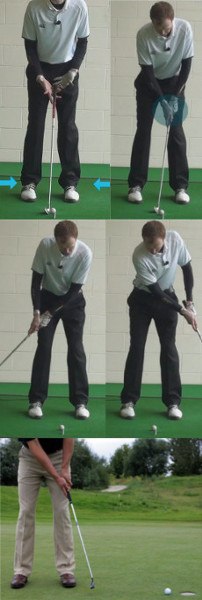
Thanks to the simplicity of the putting-style chip, it would be easy to take this shot for granted. You might be tempted into thinking that you don’t really need to practice this shot, since it is basically the same as a putting stroke anyway. That would be an error, however, and you’d never manage to achieve the results you desire. Everything in golf takes practice, and this shot is certainly no exception.
To help you make progress with your ability to play putting-style chip shots, please review the techniques and ideas below prior to your next practice session.
- Focus on distance control. The key when using a putting-style chip shot is to be able to control your distance correctly. You shouldn’t have much trouble hitting the ball on the right line, as long as you take enough time before the shot to read the slope of the green (just as you would when putting). However, the distance half of the equation can be far more challenging. During practice, judge your results mostly on how well you are able to predict the distance that the ball will travel. Also, take note of any patterns that seem to be popping up, such as consistently hitting the ball too far or too short. Being able to control your distance nicely when using a putting-style chip is a powerful tool to have available on the course.
- Try using one ball. Many golfers will drop a whole pile of golf balls on the ground when they get ready to work on their short game. That can be fine in some cases, but we like to encourage players to use just a single ball. By hitting one shot at a time – and having to walk up and retrieve that ball after every shot – you are more likely to focus on the task at hand. With a pile of balls waiting nearby, you will never worry too much about the current shot, since another ball is right there to be had. Try going through a chipping practice session with just one ball and we think you’ll enjoy an improved sense of focus and purpose.
- Experiment with different lies. We mentioned earlier that you will mostly want to use this shot from the short grass. That remains true, but there are still plenty of different situations you can encounter while on the fairway or fringe. For instance, you might have to play from an upslope, a downslope, or a sidehill lie. Try the putting-style chip shot from a variety of types of lies in order to see how the ball reacts in each situation. You never quite know what your short game will be forced to do on the course, so prepare yourself as thoroughly as possible in practice.
- Finish the job. Rather than just chipping your ball and then picking up the ball to try again, get into the habit of finishing off your up and down by making the putt. This will make your practice more closely resemble what you are going to be doing on the golf course, and that is a good thing. In fact, it is easy to turn this type of practice into a little game. Try playing nine ‘holes’ on the practice chipping green by chipping the ball up and then using your putter to finish out. The green doesn’t necessarily need to have nine different holes to make this work – you can just vary your starting position to maintain variety. At the end of your nine holes, total up the score to see how you have done. Most players set the par for this kind of drill at 18, which is obviously two strokes on every hole. It should be noted that actually finishing the drill in 18 strokes is quite difficult, and you should be proud of your accomplishment if you pull it off.
Practicing properly is one of the biggest keys to success in golf. We hope the tips above will give you some good ideas on how you can sharpen up your performance with the putting-style chip shot.





